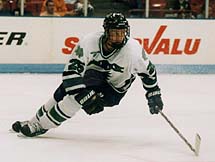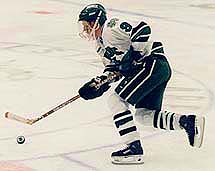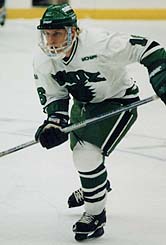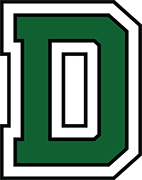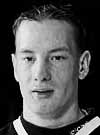Bye Bye To Two Byes
With the ECAC struggling as a whole, Hockey East fans might have begun salivating at the potential for securing both byes at the East Regional in Worcester this year.
Think again.
In the past, the byes at the East and West Regionals were reserved for teams from that same region, with preference going first to any team that won both its regular season and conference championship. Last July, however, the Division I Men’s Ice Hockey Committee voted to award byes to the top four seeded teams irrespective of region as part of other major changes to the postseason landscape.
The change to the byes process drew little attention because it was overshadowed by other more significant changes. Most notably, this included dropping the number of each conference’s automatic bids from two to one as well as the awarding of an automatic bid to the Metro Atlantic Athletic Conference (MAAC). (With five autobids, the guaranteed bye to a team that won both its conference’s regular season title and its tournament had to be eliminated.)
In fact, the change to region-blind byes was overlooked to the extent that when the recently released NCAA Ice Hockey Championships Handbook failed to excise a key paragraph, many assumed the old protocol was still in effect.
“Over the last few weeks I’ve had people ask me questions about the byes and I’d grab the book, read the wording and the wording is quite clear,” said Hockey East Commissioner Joe Bertagna earlier this week. “I wasn’t aware that that’s not the wording that they meant.
“[I’ve been told] that when they decided [to change the process,] they made it a priority — since it was such a major change — to get the word out. Not only did they not get the word out, but they got incorrect words out.
“To compound it, they never [sent out a correction.] That book has been in my office for three weeks and I have not heard a thing from the NCAA.”
The NCAA has since clarified its stance and alerted coaches and commissioners about the handbook error.
“Nothing has changed,” says selection committee chair Bill Wilkinson. “We’re going to rank the teams one through 12 and the top four, no matter which region they come from, would be the ones that would get the byes. This is just coming out of the minutes of the summer meetings.”
While acknowledging the handbook error, Wilkinson is also surprised that so many were caught off guard by the change.
“I know the coaches are confused, but they shouldn’t have been if they were at the meeting in Florida,” he says. “The minutes were probably out in August or September. They had all the information about the change that was going to take place.”
The new protocol directly affects teams like New Hampshire and Providence, the second and third-ranked Eastern teams. That fact means little now, since they are eighth and ninth, respectively, overall in the Pairwise Rankings.
Michigan State, Boston College, North Dakota and Minnesota are currently the four top teams in the country and thus are on pace for byes under the new rules. Barring a total collapse of several Western teams and a late-season winning streak by UNH or PC, it’ll be Western teams taking three of the four byes. “It would be hard to give a second bye the way things are locked in right now to a team in the East that is eighth in the country,” says Wilkinson.
Which is the central argument. The best four teams should get the four byes.
And if Boston College should suddenly stumble, the byes could conceivably go to all Western teams.
However, Wilkinson notes that this shouldn’t affect attendance. If BC and UNH are in the East Regional, but not as bye teams, their fans will still have a reason to come to the Centrum.
“I don’t think it’s a concern regarding the draw,” he says. “You’re going to have at least three teams from the East out there. If BC isn’t [seeded] one or two in the East, they’re probably going to be three, four or five. I wouldn’t expect that whoever comes out of the ECAC would be sent out West so they’d stay in the East.
“It’s just going to be a harder road [to the Frozen Four.]”
Wilkinson laughs and adds, “BC is used to it. I sent them out West the last two years [and they advanced.] They’re going to be upset if they stay in the East.”
The NCAA Picture For Hockey East
In addition to the bye issue, the significant question remains of how many Hockey East teams will make the tournament. Each of the five conferences (Hockey East, ECAC, MAAC, CCHA, WCHA) receives only one automatic berth — that going to the tournament champion — with the other seven bids going to the top teams in the selection criteria.
As it stands now, if the team highest in the criteria were to win the tournament in each conference, then Boston College, New Hampshire and Providence would be in. With no tournament upsets, 10 is the key dividing line in the Pairwise Rankings since the ECAC and MAAC are guaranteed bids, but don’t have teams among the leaders.
So as of now, Hockey East looks like it’s on pace to get three teams into the national tournament. It could get a fourth, either by virtue of a dark horse such as UMass-Lowell winning the league championship or by Maine going on a late-season run that gets it to, say, the title game where it loses. However, this might also necessitate knocking Providence out since the two teams finish the season with a couple games at Orono and could meet in the league semifinals. So four teams in the NCAAs is a possibility, but not a very strong one.
Hockey East could also conceivably get none of the wild card bids.
None?
Yes. If BC wins the league tournament and the wheels fall off at New Hampshire and Providence without Maine capitalizing enough to become a wild card entry, Hockey East could enter the NCAAs with only BC to represent it. That scenario, while still not probable, would become more plausible if an upset team that wouldn’t otherwise get a bid won the CCHA or WCHA.
For example, if Ohio State won the CCHA tournament, it would gain that league’s automatic bid. If Michigan State, Michigan or perhaps even Western Michigan finished among the top seven non-tournament winners, those teams would gain the wild card bids.
“The worst scenario right now is if the top teams in the country don’t win their tournaments,” says Wilkinson. “If some odd teams that are not in the top 12 in the country win, that shifts everything down.”
Of course, getting only one team into the tournament after coming within a clanged post of getting three Hockey East teams into the Frozen Four the past two years would prompt a predictable outcry.
And the answer here would be the same as the one given to the CCHA last year: past glories don’t guarantee high seeds or even bids. Last year, several CCHA coaches bemoaned their low seeds and this writer showed them no sympathy. That league was in a down year and got what it deserved in terms of seeding.
The same will hold this year, too, with Hockey East should its teams falter down the stretch. The league is not as dominant as in the last couple years and must earn its bids and seedings. As they say in the stock market, past performance is no guarantee of future success.
Except there is that issue about the MAAC autobid…
The MAAC Autobid and Hockey East
When the NCAA granted the MAAC an automatic bid last summer, many observers expressed surprise that it had come without an expansion to a 16-team tournament. It was one thing to give one of four new berths to the fledgling league, but another to take one away from the established four conferences. After all, last season the MAAC had failed to win a single game against the Big Four leagues.
“What’s not right is the NCAA not giving us 16 teams,” said Northeastern coach Bruce Crowder early this season when his Huskies looked like a potential bubble team. “That’s what’s not right.
“I don’t think you’d have the problem with the MAAC getting a bid or even [the CHA] getting a bid to promote college hockey, which is what we’re supposed to do, [if we got 16 teams in.] That’s the real crime with what’s happening in my eyes.”
Bertagna, however, debunks the linking of the tournament expansion with the MAAC’s autobid.
“The MAAC got the autobid because it deserved it,” he says. “It met all the NCAA’s procedural criteria for a league.
“We knew all along that it was going to be difficult to get the 16-team tournament. The MAAC’s autobid was a separate issue. They got it because they should have gotten it.”
(The NCAA rules which dictated the MAAC inclusion — two years playing at the Division I level — have since been modified, preventing the CHA from also gaining an autobid until several additional years of play.)
Given that the rules then in place dictated the MAAC autobid — it was not granted in a gesture of goodwill, but rather the simple byproduct of the rules — the question remains as to whether it is good for college hockey, fair to all of the teams and, in general, a good idea or a bad one.
“They’ve got to do things to promote college hockey,” said Crowder. “The situation with the MAAC coming in — you’ve got to try to give some legitimacy to the league and that’s the only way you’re going to do it. In a way it’s not right, but in another way it’s right for the development of college hockey.”
Providence coach Paul Pooley, whose Friars also looked like a bubble team early and could potentially fall to that status, offered some first-hand experience.
“You can go both sides of the fence on that,” he said. “I remember when I was at Ohio State [as a player.] In my senior year, we had 30 wins and didn’t get a bid because the CCHA didn’t have the respect.”
While the CCHA did place two teams in the NCAA tournament that year and Bowling Green won the national championship, one year earlier only one team from the league had gotten a bid despite similar records, in part because the more-established WCHA was considered stronger and received three berths.
“If you don’t give an opportunity to a league to get in, how are they ever going to get better?” said Pooley. “Selfishly, you look at it one way. >From a college hockey perspective, you’ve got to look at it that other way.
“You’ve got to foster a league. We’ve got six leagues. Is this going to make college hockey better? It’s going to give us more exposure. But it’s a very difficult question to answer.”
One fly in the ointment is that the MAAC limits teams to only 11 scholarships, which puts them at an almost untenable disadvantage when going against programs with the NCAA limit of 18. Other than the Ivy League schools — which give no purely athletic scholarships, but are perhaps a special recruiting case — almost every other Division I program gives a full 18.
In light of that, is it sensible to grant an automatic berth to a league which limits its members in such a way as to almost guarantee that they can’t compete with the Division I elite? At present, the MAAC’s top team, Quinnipiac, is ranked 20th in the selection criteria.
“There’s no question that 11 scholarships are a limitation,” says Quinnipiac Athletic Director Jack McDonald, one of the driving forces in the formation of the MAAC. “There’s no question that the MAAC members know that they need to review this. The league was started with the intent of trying to be a little, shall we say, cost sensitive and gender [equity] sensitive.
“But every student-athlete goes to school for two reasons. One is to get their degree. The other is to make the nationals. So we’re really pleased that hockey and all of our sports here at Quinnipiac now have access to the national championship.
“I certainly respect the tradition of the great four leagues, but as an athletic director I have a lot of sports who give less scholarships than the national powers who have access to the national championship. In college hockey, there’s no question that this is a break from the norm. It remains to be seen when the MAAC champion plays in March how they’ll do.”
Which, of course, is the million dollar question. None of the MAAC teams have displayed the nonconference prowess of Niagara last year, but if the team that does get the bid can even come close to the Purple Eagles’ performance then no one will be looking askance at the autobid.
“We are very fearful,” says McDonald. “We’re excited on the one hand that the MAAC team will get to play in the national championships, but on the other hand we’re nervous that if it were to be an embarrassing loss, the public perception would not be good.”
Quinnipiac, for one, won’t be content long-term to get autobids and merely be a sacrificial lamb. As a result, it is leading a push for more MAAC scholarships, a move that would put league schools on a more even footing with its established counterparts.
“We want to award our [hockey] teams 18 scholarships,” says McDonald. “We feel that anybody that makes a commitment to Division I needs to know that that’s the limit [not lower]. If they as an institution make a decision not to give 18, we certainly respect that, but to hold others back is not right.
“Without question, the MAAC membership is considering upgrading scholarships. It’ll take some time. For example, we increased the MAAC lacrosse scholarships because they’re receiving an automatic bid in 2003. I know that MAAC hockey scholarships is something that frankly will take some time, but I do think in time the MAAC will increase [the limit.]
“If they don’t, Quinnipiac will be making a decision. We aspire to be the best that we can be. We would like to get 18. Hopefully, that will be within the MAAC. If it’s not, we’ll obviously have some thinking to do.”
One would hope that the MAAC will eventually opt for 18 scholarships or at least a number a lot closer than 11. One of the beauties of the NCAA hockey tournament is that the top and bottom teams are so competitive. There are no Duke vs. Podunk State matchups.
If 10 years from now, however, the MAAC is still stuck at 11 scholarships, content with its autobid, we’re likely to see post-season massacres with regularity.
A “Shorter” Season And A House Divided
As if there weren’t enough MAAC talk here in HockeyEastLand, an NCAA proposal to remove one week of games in October has much of the league in an uproar. Originally, the ECAC sought a specific uniform starting date for practices with a uniform starting date of games to follow two weeks later. Since the MAAC is a multi-sport conference with more weight in the NCAA, the ECAC asked the MAAC to put the proposal forward.
Since then, the other conferences have weighed in on the issue. While there were concerns about the specifics of the uniform date for first practices, it was the loss of a week of games in October that set off fireworks. The ECAC has since retracted its support, but the MAAC hasn’t wavered.
“I’m not the spokesman for this, but unofficially I am,” says McDonald. “We would just like to have a consistent starting date for practices and games. That’s all the intent is. If it would happen to be July 4th, so be it.
“As an athletic director, I can take out a book and say when my first soccer practice and game is, or basketball practice and basketball game. It’s very, very unclear and cloudy in hockey. Different schools do it different ways based on sometimes taking weeks off during the year.
“We’d like to have a little more like Midnight Madness for college hockey. In 1970, the first BC hockey game was in December. Now it’s Oct. 7. There has been significant change in the schedules.”
To be fair, the era of seasons starting in December also included games all the way through Dec. 23. Presumably, the opportunity to go back home for a couple weeks during Christmas break is a welcome one to most student-athletes that makes up for some of the earlier starting dates.
Also, BC played only 26 games back in 1970, a figure that doesn’t fit today’s profile. Further, the formation of new leagues and the corresponding elimination of independent teams has resulted in significantly less scheduling flexibility than in past years, especially for a league like Hockey East with an odd number of teams.
Furthermore, while teams in the Northeast can schedule midweek games because of the proximity of most teams, such options aren’t available to those in Colorado or Alaska or throughout the West. These teams feel that the loss of a week in an environment that is already difficult to schedule turns a difficult situation into a near-impossible one.
The MAAC proposal also doesn’t change the total number of days that student-athletes will practice and play. They remain 22 weeks and 132 days.
As a result, the other five conferences and the American Hockey Coaches Association (AHCA) have asked that the MAAC drop the proposal. In what many feel is a breach of college hockey etiquette, the league has refused.
Which has prompted short fuses and fireworks.
“I like the idea of giving the MAAC a bid, but not if the MAAC turns around and tries to shorten our season by introducing legislation at the NCAA level,” says one livid Hockey East coach. “We’ve given them a chance to play [at our level] and now they want to lower the league. They want to bring the game down to their level.
“There are going to be some fireworks at the convention. The power play they tried to pull with the NCAA legislation is just [outrageous]. I’m glad that Joe [Bertagna] as Executive Director [of the AHCA] has come out and said that college hockey is not for this.
“For [the MAAC] to do that, it certainly tells us that they don’t appreciate what college hockey has given them. I think it’s time that we take a real hard look at withdrawing their bid.
“By their move, we’ve got to send a message to them. They’ve either got to be part of the family or they want to be out of the family. If they want to be out of the family, get rid of the bid.”
Whew!
While Bertagna is every bit as upset about the issue, he dismisses talk of withdrawing the automatic bid to the tournament, saying “I’m not aware of any procedure where the automatic bid could be taken away.”
That said, Bertagna remains extremely upset that the fledgling league continues to pursue the matter despite the opposition of every other league. He also counters a suggestion from McDonald that the athletic directors are behind the proposal even while the coaches are not.
“The only time it’s been addressed directly [to the Hockey East athletic directors] was in September at our athletic directors’ meeting when we got wind that the ECAC was going to go ahead with the original proposal,” says Bertagna. “I went to the athletic directors and asked them if they would give me the permission to write to the ECAC and ask them to withdraw it because A) there was no consensus and B) there were parts that we opposed, i.e., the starting date for the games. They gave me the green light to write that letter.
“My assumption, although we haven’t taken a vote on it, is that there may indeed be support for a common date for practice, but that’s not the issue right now. Everybody has kind of felt that the concept of a starting date for practice is fine. It’s how we identify what the date is. You could say Oct. 1 or the Saturday closest to Oct. 1. You should say 25 weeks [back from the NCAA tournament].
“There are a lot of ways you could come to that date. That discussion never took place in the greater hockey community. Basically, we were given this formula from the ECAC first and then through the MAAC. Our protest at that time was not so much against the concept, but the actual date.
“More vigorously now, the protest is against mandating a starting date for games. If this was just a matter of counting back 25 weeks and that’s the first practice, I think that passes, everything is harmonious and we can pat ourselves on the back for having accomplished something.
“The problem where we stand right now is that one league is in my opinion thumbing its nose at five other leagues and the coaches association and refusing to withdraw that part that mandates that you have to wait two weeks before you play a game.”
The dispute has also become personal between Bertagna and MAAC Commissioner Rich Ensor. In an earlier commentary, Bertagna made reference to the length of the season in an attempt to soften his words. Ensor then used the quote out of context in his attempt to push the proposal forward.
“I’d be less than honest if I suggested it wasn’t a bone of contention with me,” says Bertagna, “when somebody not only misrepresents my position for their own strategy, but when they’re confronted [on a conference call with the other commissioners] says, ‘I don’t care!’ That’s a direct quote.
“Even after that exchange, Ken Taylor, who is the number two guy [at the MAAC], wrote a commentary in the NCAA News and did the same thing. He used the same quotes. I’m sure he was acting at the direction of his boss.”
While noting the personal friction, Bertagna has tried to emphasize the hockey aspect.
“There are two issues and the more important issue is the hockey issue, not the personal one,” says Bertagna. “The other issue is a personal issue and it should remain clearly secondary.
“We feel as a sport that we’re sometimes given limitations by the NCAA that are not of our doing. We always have a struggle of fighting within the NCAA.
“What we haven’t had to do is fight amongst ourselves. There’s always been the feeling that a minority position wouldn’t be advanced. The more important issue here is that we have a split in the ranks and we have one league trying to tell the other five what to do.
“This is nothing that I’ve ever had to deal with before. I’ve been around this game a long time and we’re a pretty close community. It is a bone of contention that somebody who isn’t a hockey guy and is new to the game shows what I feel is a lack of respect in this process.
“But most importantly, it’s in the process of doing something that isn’t good for our sport.”
McDonald offers a final telling comment.
“I’m disappointed that this is all happening,” he says. “If this thing could go away, I wouldn’t mind having it go away, particularly for the MAAC. We don’t need this.”
With the other five conferences against the measure, McDonald’s words offer the only sensible solution as this writer sees it.
The Rooting Interest From The Bubble
If the season ended today, Boston College, New Hampshire and Providence would be in the national tournament. UMass-Lowell, Boston University, Northeastern, Merrimack and UMass-Amherst all must win the Hockey East tournament to gain an NCAA berth.
Only Maine sits on the bubble. Presently the Black Bears are on the outside looking in, but are close enough to qualify without also winning the league tourney.
Maine-iacs keeping a close eye on the Pairwise Rankings may have noticed that after Friday’s win over a hot Lowell club, the Black Bears fell in the rankings. That’s because one team’s success doesn’t happen in a vacuum. In this case, both Western Michigan and Wisconsin leapfrogged Maine because of even bigger wins over Michigan State and St. Cloud, respectively.
As a result, here’s a look at the teams that bubble-bound Black Bear fans — say that five times fast — should start rooting against. They are teams that Maine currently loses its selection criteria comparisons to, but still remain in striking range of: Providence College, St. Cloud, Western Michigan, Wisconsin, Denver, Cornell and Canisius.
Check out the (very large) individual comparisons page for more detail.
East Regional Tickets
Reportedly, over 6000 tickets have already been sold to the East Regional in Worcester. A word to the wise, then, for those fans planning to attend, but who haven’t yet put their money where their mouth is. Click on NCAA Tournament on the left sidebar for details.
Parker, Parker And More Parker
With BU coach Jack Parker about to celebrate his 1000th game as a coach on Friday at Matthews Arena, it was fitting timing that “Jack Parker’s Head Coaching Records” appeared last week. Compiled by Terrier fan Sean Pickett, the collection includes statistics ranging from the truly significant all the way to obscurity and beyond.
To whit: Parker’s well-documented success in the Beanpot (42-14-0, .750) is matched percentage-wise by that in the Colonial Bank Holiday Invitational, the Syracuse Invitational Tournament and the Mariucci Classic (all at 3-1, .750). It is almost matched by his record in the ECAC Tournament (18-6-1, .740).
Obviously, he has more wins at Walter Brown Arena, 309, than at any other of the 61 rinks he’s coached at, but second place goes to the Boston Garden, where he won 49. Matthews Arena, the site of Parker’s 1000th game, ranks third with 22. He was 1-4-0 in the old Mariucci Arena, but 3-1-0 in the new one.
He’s had more ties against New Hampshire and Boston College, 5, than any other opponent. Northeastern has provided the most wins, 67. And Boston College, the most appearances, 99.
Of the 102 coaches he’s gone up against, Parker enjoyed 31 wins against former BC coach Len Ceglarski, 29 over former Merrimack mentor Ron Anderson and 27 when facing Maine coach Shawn Walsh.
You get the picture…
Hey, Paisan!
Good guy and Lawrence-Eagle Tribune writer Kevin Conway has coined the year’s best nickname to describe Merrimack’s trio of Anthony Aquino, Marco Rosa and Nick Parillo. Conway’s creation? The Ba-da-bing Line.
Hey, you got a problem with that?
Plus-Minus
A few weeks back, Eugene G. Bernardo II wrote to question the selection of BC’s J. D. Forrest on my half-season all-rookie team instead of UNH’s Mick Mounsey (or as he’s known to Granite Staters: Mick Mounsey of Concord). Eugene pointed out that the plus-minus statistics on hockeyeastonline.com for the two players tilted heavily to Mounsey. At the time, Mounsey was plus-15 while Forrest was minus-1.
As it turns out, however, Hockey East makes no claims that the plus-minus statistics on its website are accurate. Since it’s part of their statistics program, the stat shows up even though roughly half of the league teams don’t keep it. Since Boston College is one of those clubs, there are no plus-minus stats kept for most BC games. As a result, the team plus-minus is listed as only plus-35 when the Eagles actually have the best goal differential in the league.
As an added point, many coaches are loathe to give the stat any attention anyway.
“I don’t even use it,” says Northeastern coach Bruce Crowder. “So and so is on a line change and he has nothing to do with the play and he gets stuck with a minus because he stepped on the ice. As much as it can be a negative on the defensive side, it can also get a kid a plus who did nothing on the play.
“We use a [modified] plus-minus that we get off the videotape.”
Crowder then refers to a FOX TV note that he’d used 65 line combinations by the end of January.
“Plus-minus is one of those useless stats,” he says. “Right up there with 65 line combinations.”
A Shame
It’s truly a shame to see a talented player like Northeastern defenseman Rich Spiller wash out. This year’s media guide quoted Crowder as saying, “If Rich decides he wants to be one of the best hockey players in the country, I think he has that capability. If he puts his mind to it, he can do it.”
Apparently, Spiller went in the opposite direction. Crowder dismissed him from the team before last weekend’s games, saying, “His inability to have accountability is something we’ve had enough with.” The last straw was reportedly his missing the team bus to the Beanpot consolation game.
Spiller played in 95 games, accumulating a 4-18-22 scoring line.
There are feel-good stories of walk-ons turned significant contributors… and then there are shake-your-head sad stories like this one.
Trivia Contest
Last week’s question came from the Boston Herald‘s John “Jocko” Connolly and asked: what do former collegians Scott Harlow (BC), Paul “The Shot” Hurley (BC), Nick Vachon (BU), Christian Soucy (Vermont) and Jim Stewart (Holy Cross) have in common?
Clearly, many of you have the good taste to read Jocko since correct answers to this tough question came in fast and furious.
Mark Divver was first to answer that all five players enjoyed NHL careers of exactly one game. As a result, his unique cheer is:
“Go Rhode Island, U-R-I!”
On a side note, Paul Gentile notes that all five players have famous movie star surnames:
Scott Harlow = Jean Harlow Paul Hurley = Liz Hurley Christian Soucy = Pete Soucy Nick Vachon = Javier Vachon Jim Stewart = well, Jimmy Stewart
Paul also offers a long list of even more one-game collegians, many of them goaltenders: Jamie Ram (Michigan Tech), John Aiken (BU), Dean Clark (Ferris State), Don Waddell (Northern Michigan), John McCahill (Michigan), Wayne Cowley (Colgate), Jim Cunningham (Michigan State), Parris Duffus (Cornell), Corrie D’Alessio (Cornell), Dan Ratushny (Cornell), Michael Gaul (St. Lawrence), Pat Meyer (U.S. International – NCAA), Colin Chisolm (U. of Alberta – CIAU), Jeff Libby (Maine) and probably Derek Bekar (UNH).
Whew! Without the time to confirm all of those, let’s just induct Paul into the Get-A-Lifer Hall of Fame right now. Of course, in these circles that is considered a high compliment.
Thanks, Paul, and how ’bout them River Hawks?
Scott McNey points out an oversight in a previous trivia question, the one which noted that only Anthony Aquino and Mike Maturo had scored more than one goal in a game this year against Ty Conklin. Scott correctly notes that Chris Heisten should also be added to the list. Unfortunately, yours truly wrote the trivia question part of that column on Sunday and neglected to check if any Black Bears turned the feat in that evening’s game.
Thanks, Scott.
This week’s question asks: who is the youngest player in Hockey East this year?
Send your answers or wild guesses to Dave Hendrickson.
The following is taken from the Ice Hockey Championships Handbook, page 15. Under the topic “Determination of Competing Institutions (Division I Men)” and under the subtopic of “Seeding and Pairings” are seven articles, the fourth of which was supposed to be removed, but was not.
Seeding and Pairings [Reference: Championship Structure in this handbook and Bylaw 31.1.3 in the NCAA Manual.]
The Division I Mens Ice Hockey Committee will seed the selected participants as follows: 1. The top four seeds will be determined by the selection criteria. These teams will receive first-round byes.
2. Teams will be seeded within their respective geographical regions.
3. Should the number of teams selected from the regions be unequal, the lower seeded team(s) in the region with the higher number of teams will be shifted to represent the other region in order to equalize the regional seedings.
4. A team moved from one region to the other may not be seeded higher than No. 3. Therefore, the No. 1 and No. 2 seeds in each regional shall be teams from that region.
5. Four teams from the East region may be placed in the East regional bracket along with two teams representing the West region.
6. Four teams from the West region may be placed in the West regional bracket along with two teams representing the East region.
7. When possible, first-round conference matchups will be avoided.
Thanks to Lee Urton, Adam Wodon and Jayson Moy for their assistance.
